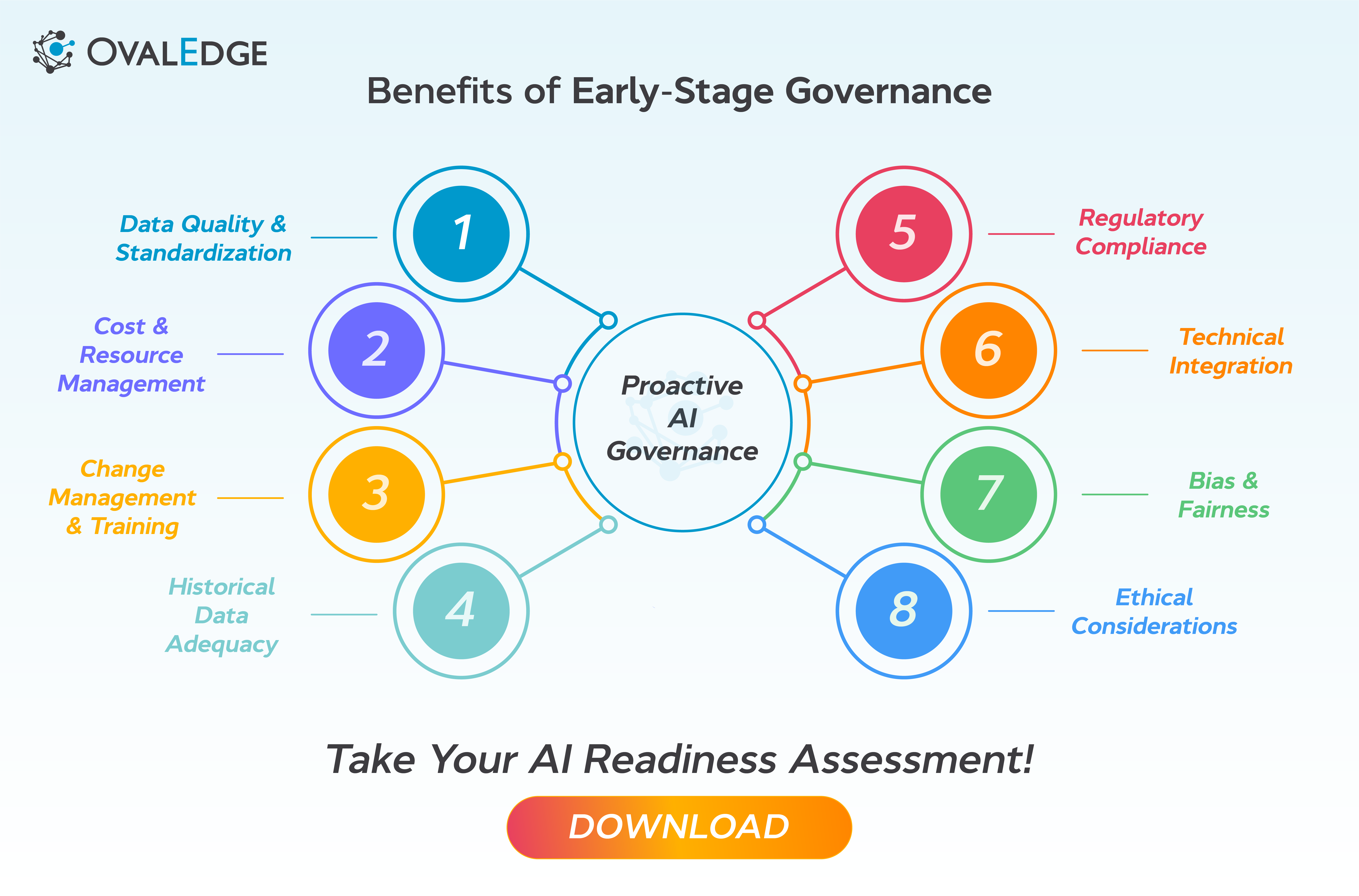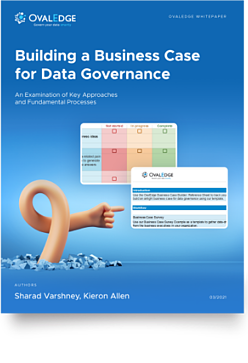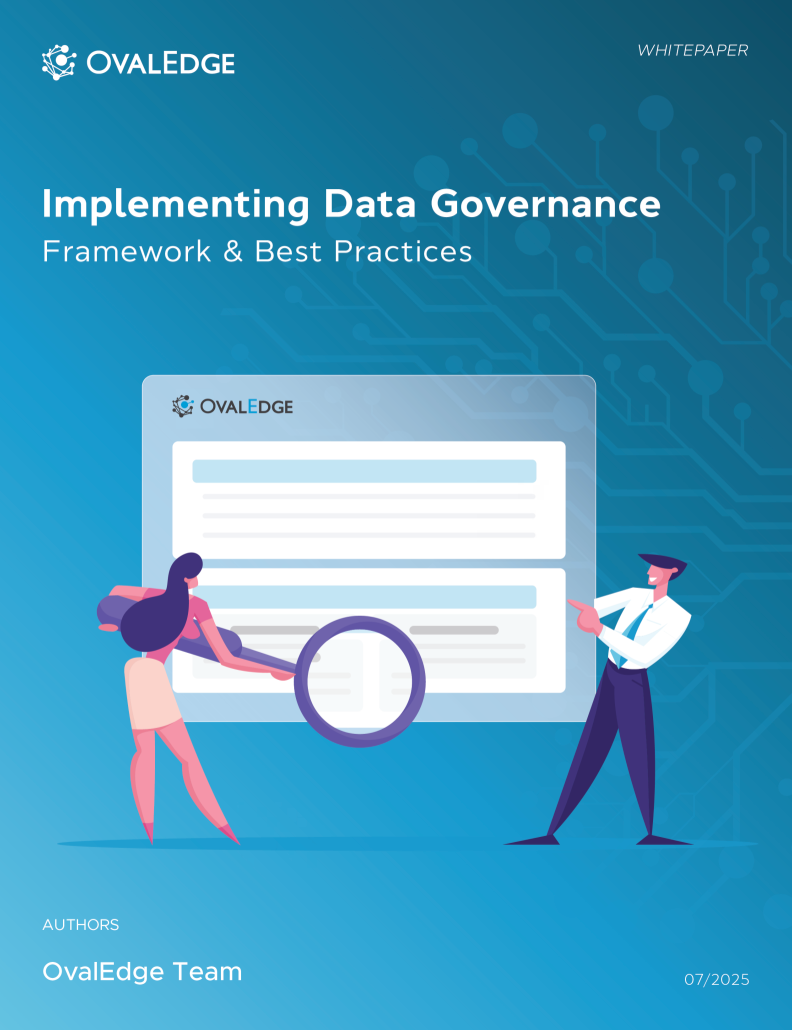Table of Contents
Why AI Governance Should Begin During Design, Not Deployment
In this blog, we’ll explain why AI governance must be built into the design of AI tools and not introduced at deployment.
Picture this. A hospital collects patient data without a structured approach. That hospital faces significant difficulties when later attempting to introduce AI for predictive analytics or personalized medicine. Why? Because quality and standardization issues, such as inconsistencies, incompleteness, and unstructured formats, require extensive cleaning and preprocessing before AI models can utilize the data effectively.
Similarly, a manufacturing company that relies on traditional maintenance schedules for its machinery faces substantial challenges when implementing AI for predictive maintenance later down the line. The lack of comprehensive historical data on machine performance and failures impacts the training of accurate predictive models.
What’s more, existing machinery often requires retrofitting with sensors to collect necessary real-time data, incurring additional costs and causing potential downtime. The transition also demands significant change management efforts, as operators and maintenance staff need training to understand and trust AI-driven maintenance recommendations.
Moreover, integrating AI systems with existing production management and monitoring systems presents technical complexities, further delaying the realization of AI’s benefits.
Similarly, a financial institution that relies on manual or rule-based systems for fraud detection faces several challenges when transitioning to AI-based methods. Historical transaction data may not be adequately annotated with fraud labels, complicating the training of supervised learning models.
Early AI implementations might exhibit higher rates of false positives or negatives due to the lack of high-quality training data. Furthermore, introducing AI requires additional compliance checks and adjustments to ensure regulations are met. The complexity of integrating AI with existing legacy systems adds to the difficulties, making the shift to AI-driven fraud detection a formidable task.
The above three examples demonstrate why AI governance must be established during the design phase, not at deployment.
Related Post: What is AI Governance?
Why Early-Stage Governance is Critical for AI
Implementing AI governance at the start of the development process should be a primary objective for any organization launching an AI initiative. Doing so safeguards your company from a range of risks that can seriously impact your business.
As the above examples demonstrate, proactive AI governance is crucial for the following reasons:
1. Data quality and standardization
Proactive AI governance ensures data is collected, stored, and processed in a standardized, structured manner from the outset, facilitating easier integration and utilization by AI models.
2. Cost and resource management
Early-stage AI governance helps identify necessary technological and procedural upgrades beforehand, allowing for more efficient allocation of resources and minimizing unexpected costs and disruptions.
3. Change management and training
Implementing governance from the start ensures that organizational changes and staff training are planned and executed smoothly, fostering better acceptance and understanding of AI technologies.
4. Historical data adequacy
Proactive governance mandates proper data annotation and documentation practices from the beginning, enabling more effective training and performance of AI models.
5. Regulatory compliance
Establishing AI governance early ensures that compliance with existing and future regulations is built into the development process, reducing the risk of legal issues and ensuring smoother integration with existing systems.
6. Technical integration
Early AI governance frameworks address technical integration challenges by planning for compatibility and interoperability from the design phase, accelerating the realization of AI benefits.
7. Bias and fairness
Proactive AI governance includes measures to identify and mitigate biases during the design phase, ensuring fair and unbiased outcomes.
8. Ethical considerations
Early governance establishes ethical guidelines and frameworks, promoting transparency, accountability, and user consent from the beginning, which is essential for building trust and ensuring responsible AI deployment.
Conclusion
Proactive AI governance is crucial to ensuring the successful implementation of AI technologies. By establishing governance frameworks during the design phase, organizations can standardize data collection, manage costs, and facilitate change management and training.
This approach ensures historical data adequacy, regulatory compliance, and smooth technical integration. Additionally, proactive governance addresses bias and fairness, and establishes ethical guidelines, promoting transparency, accountability, and user trust.
OvalEdge recognized as a leader in data governance solutions
.png?width=1081&height=173&name=Forrester%201%20(1).png)
“Reference customers have repeatedly mentioned the great customer service they receive along with the support for their custom requirements, facilitating time to value. OvalEdge fits well with organizations prioritizing business user empowerment within their data governance strategy.”
.png?width=1081&height=241&name=KC%20-%20Logo%201%20(1).png)
“Reference customers have repeatedly mentioned the great customer service they receive along with the support for their custom requirements, facilitating time to value. OvalEdge fits well with organizations prioritizing business user empowerment within their data governance strategy.”
Gartner, Magic Quadrant for Data and Analytics Governance Platforms, January 2025
Gartner does not endorse any vendor, product or service depicted in its research publications, and does not advise technology users to select only those vendors with the highest ratings or other designation. Gartner research publications consist of the opinions of Gartner’s research organization and should not be construed as statements of fact. Gartner disclaims all warranties, expressed or implied, with respect to this research, including any warranties of merchantability or fitness for a particular purpose.
GARTNER and MAGIC QUADRANT are registered trademarks of Gartner, Inc. and/or its affiliates in the U.S. and internationally and are used herein with permission. All rights reserved.



.webp)


